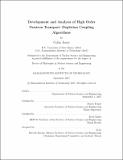Development and analysis of high order neutron transport-depletion coupling algorithms
Author(s)
Josey, Colin
DownloadFull printable version (2.302Mb)
Other Contributors
Massachusetts Institute of Technology. Department of Nuclear Science and Engineering.
Advisor
Benoit Forget.
Terms of use
Metadata
Show full item recordAbstract
The coupling of depletion and neutron transport together creates a particularly challenging mathematical problem. Due to the stiffness of the ODE, special algorithms needed to be developed to minimize the number of transport simulations required. In addition, for stochastic transport, both the time step and the number of particles per time step need to be considered. In recent years, many new coupling algorithms have been developed. However, relatively little analysis of the numeric and stochastic convergence of these techniques has been performed. In this document, several new algorithms are introduced. Some are improvements of current techniques, some are taken from similar problems in other fields, and some are derived from scratch for this specific problem. These were then tested on several test problems to investigate their convergence. With regard to numerical error, the CF4 algorithm (a commutator-free Lie integrator) outperformed all tested algorithms. In number of transport simulations to achieve a 0.1% gadolinium relative error, CF4 requires half the simulations. With regard to stochastic error, it was found that once a time step is sufficiently reduced, errors are mostly a function of the number of particles used during the simulation. The remaining variability is due to how stochastic noise propagates through each numerical integrator. Using this information, a technique is developed to minimize the cost of running a depletion simulation.
Description
Thesis: Ph. D., Massachusetts Institute of Technology, Department of Nuclear Science and Engineering, 2017. This electronic version was submitted by the student author. The certified thesis is available in the Institute Archives and Special Collections. Cataloged from student-submitted PDF version of thesis. Includes bibliographical references (pages 141-145).
Date issued
2017Department
Massachusetts Institute of Technology. Department of Nuclear Science and EngineeringPublisher
Massachusetts Institute of Technology
Keywords
Nuclear Science and Engineering.